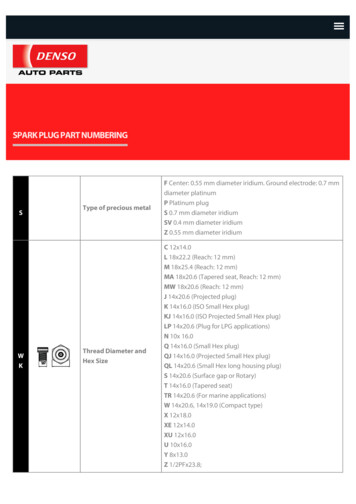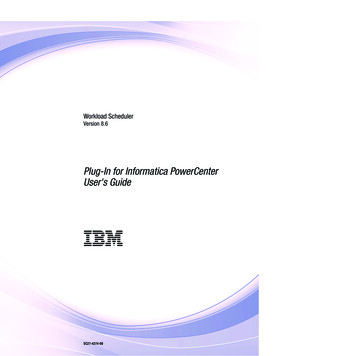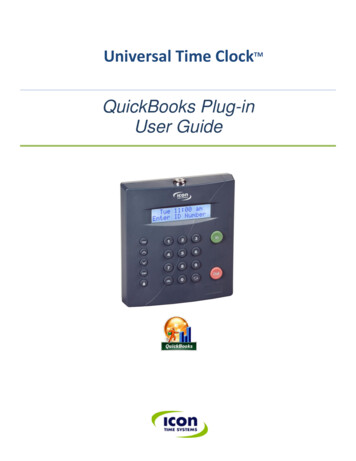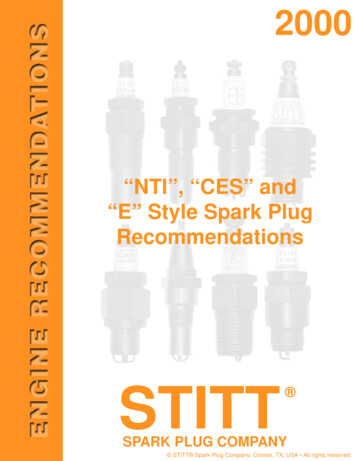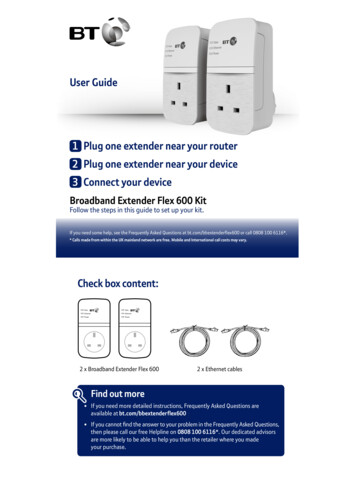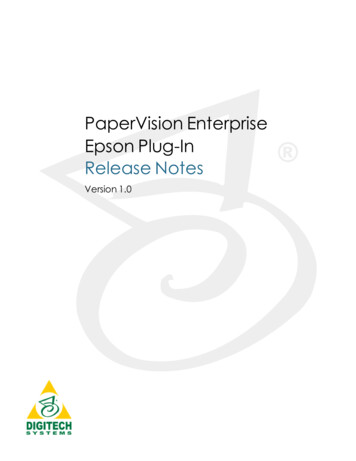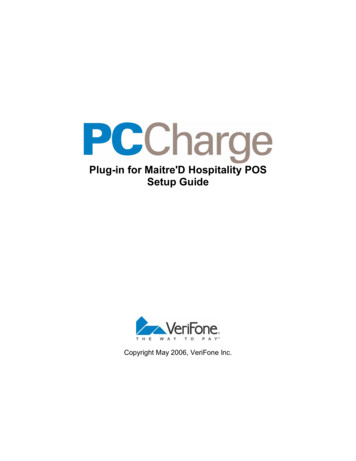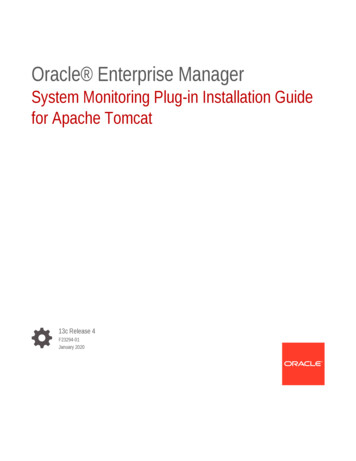
Transcription
Oracle Enterprise ManagerSystem Monitoring Plug-in Installation Guidefor Apache Tomcat13c Release 4F23294-01January 2020
Oracle Enterprise Manager System Monitoring Plug-in Installation Guide for Apache Tomcat, 13c Release 4F23294-01Copyright 2014, 2020, Oracle and/or its affiliates. All rights reserved.This software and related documentation are provided under a license agreement containing restrictions onuse and disclosure and are protected by intellectual property laws. Except as expressly permitted in yourlicense agreement or allowed by law, you may not use, copy, reproduce, translate, broadcast, modify,license, transmit, distribute, exhibit, perform, publish, or display any part, in any form, or by any means.Reverse engineering, disassembly, or decompilation of this software, unless required by law forinteroperability, is prohibited.The information contained herein is subject to change without notice and is not warranted to be error-free. Ifyou find any errors, please report them to us in writing.If this is software or related documentation that is delivered to the U.S. Government or anyone licensing it onbehalf of the U.S. Government, then the following notice is applicable:U.S. GOVERNMENT END USERS: Oracle programs, including any operating system, integrated software,any programs installed on the hardware, and/or documentation, delivered to U.S. Government end users are"commercial computer software" pursuant to the applicable Federal Acquisition Regulation and agencyspecific supplemental regulations. As such, use, duplication, disclosure, modification, and adaptation of theprograms, including any operating system, integrated software, any programs installed on the hardware,and/or documentation, shall be subject to license terms and license restrictions applicable to the programs.No other rights are granted to the U.S. Government.This software or hardware is developed for general use in a variety of information management applications.It is not developed or intended for use in any inherently dangerous applications, including applications thatmay create a risk of personal injury. If you use this software or hardware in dangerous applications, then youshall be responsible to take all appropriate fail-safe, backup, redundancy, and other measures to ensure itssafe use. Oracle Corporation and its affiliates disclaim any liability for any damages caused by use of thissoftware or hardware in dangerous applications.Oracle and Java are registered trademarks of Oracle and/or its affiliates. Other names may be trademarks oftheir respective owners.Intel and Intel Xeon are trademarks or registered trademarks of Intel Corporation. All SPARC trademarks areused under license and are trademarks or registered trademarks of SPARC International, Inc. AMD, Opteron,the AMD logo, and the AMD Opteron logo are trademarks or registered trademarks of Advanced MicroDevices. UNIX is a registered trademark of The Open Group.This software or hardware and documentation may provide access to or information about content, products,and services from third parties. Oracle Corporation and its affiliates are not responsible for and expresslydisclaim all warranties of any kind with respect to third-party content, products, and services unless otherwiseset forth in an applicable agreement between you and Oracle. Oracle Corporation and its affiliates will not beresponsible for any loss, costs, or damages incurred due to your access to or use of third-party content,products, or services, except as set forth in an applicable agreement between you and Oracle.
ContentsPreface123AudienceivDocumentation AccessibilityivConventionsivWhat's ChangedivApache Tomcat Plug-in Overview and PrerequisitesAbout Apache Tomcat1-1Supported Versions1-1Apache Tomcat Plug-in Prerequisites1-1Downloading the Apache Tomcat Plug-in1-2Deploying the Plug-in1-2Upgrading the Plug-in1-3Undeploying the Plug-in1-3Discovering Apache Tomcat TargetDiscovering Apache Tomcat Targets2-1Verifying and Validating the Plug-in2-2Metrics, Reports, and Alerts ProvidedMetrics Collected3-1Reports3-1Alerts3-2Indexiii
PrefacePrefaceThis document provides installation instructions and configuration information for theNon-Oracle Middleware plug-in for Apache Tomcat.AudienceThis document is intended systems and database administrators tasked withmonitoring Apache Tomcat through Enterprise Manager Cloud Control.Documentation AccessibilityFor information about Oracle's commitment to accessibility, visit the OracleAccessibility Program website at http://www.oracle.com/pls/topic/lookup?ctx acc&id docacc.Access to Oracle SupportOracle customers that have purchased support have access to electronic supportthrough My Oracle Support. For information, visit http://www.oracle.com/pls/topic/lookup?ctx acc&id info or visit http://www.oracle.com/pls/topic/lookup?ctx acc&id trs if you are hearing impaired.ConventionsThe following text conventions are used in this document:ConventionMeaningboldfaceBoldface type indicates graphical user interface elements associatedwith an action, or terms defined in text or the glossary.italicItalic type indicates book titles, emphasis, or placeholder variables forwhich you supply particular values.monospaceMonospace type indicates commands within a paragraph, URLs, codein examples, text that appears on the screen, or text that you enter.What's ChangedThis table provides a brief overview of the document changes for the latest publicationof the Oracle Enterprise Manager System Monitoring Plug-in Installation Guide forApache Tomcat:iv
PrefacePartNumberChange SummaryE73485-01Updated for Enterprise Manager Cloud Control 13c Release 13.2.1.0.v
1Apache Tomcat Plug-in Overview andPrerequisitesThis chapter provides an overview description of the Oracle system monitoring plug-infor Apache Tomcat and summarizes the prerequisites required before configuration.The following topics are provided: About Apache Tomcat Supported Versions Apache Tomcat Plug-in Prerequisites Downloading the Apache Tomcat Plug-in Deploying the Plug-in Upgrading the Plug-in Undeploying the Plug-inAbout Apache TomcatApache Tomcat is an open source application server that implements the Java Servletand Java Server Pages (JSP) specifications, providing an environment for Java codeto run in. The Non-Oracle Middleware plug-in for Apache Tomcat extends OracleEnterprise Manager Cloud Control 13c to add support for managing it.By deploying the plug-in within your Cloud Control environment, you can usemanagement features, such as availability and performance metrics, reports, andalerts.Supported VersionsThis plug-in supports the following versions of products: Enterprise Manager Cloud Control 13c and higher (Oracle Management Serviceand Oracle Management Agent). Apache Tomcat 8.x and later. Apache Tomcat 7.x and earlier.Apache Tomcat Plug-in PrerequisitesThe following prerequisites must be met before you can deploy the plug-in:1.Apache Tomcat is installed.2.Remote JMX monitoring must be enabled when you start Apache Tomcat. Youcan enable JMX by adding -Dcom.sun.management.jmxremote.port to thefollowing startup scripts:1-1
Chapter 1Downloading the Apache Tomcat Plug-in For UNIX and Linux: catalina.sh For Microsoft Windows: catalina.batFor more information about remote monitoring and management, refer to thefollowing es/guides/management/index.html3.Enterprise Manager Cloud Control 13c Release 13.1.0.1.0 or higher (OracleManagement Service and Oracle Management Agent) is installed.You can install the Management Agent on the same computer as Apache Tomcat(referred to as local Agent monitoring) or on a different computer (referred to asremote Agent monitoring). The way you configure the local or remote ManagementAgent is the same.If you are using a remote Management Agent, then ensure that the ManagementAgent has access to the computer on which Apache Tomcat instance is runningand the JMX port on which it is listening.4.For monitoring an Apache Tomcat target, do not use a Management Agent that isalready monitoring one of the following: Oracle WebLogic Managed Server IBM WebSphere Application Server JBoss Application ServerThis is because different target types use different JMX versions, which could leadto metric collection errors for Apache Tomcat.The following is an example of such a metric collection error for Apache ception:oracle.sysman.emSDK.emd.fetchlet FetchletException:java.lang.SecurityException: sealing violation: package javax.management issealedDownloading the Apache Tomcat Plug-inYou can download plug-ins in online or offline mode. Online mode refers to anenvironment where you have Internet connectivity, and can download the plug-indirectly through Enterprise Manager from My Oracle Support. Offline mode refers to anenvironment where you do not have Internet connectivity, or where the plug-in is notavailable from My Oracle Support.See the Managing Plug-ins chapter in the Oracle Enterprise Manager Cloud ControlAdministrator's Guide for details on downloading the plug-in in either mode.Deploying the Plug-inYou can deploy the plug-in to an Oracle Management Service instance using theEnterprise Manager Cloud Control console, or using the EM Command Line Interface(EMCLI). While the console enables you to deploy one plug-in at a time, the commandline interface mode enables you to deploy multiple plug-ins at a time, thus saving plugin deployment time and downtime, if applicable.1-2
Chapter 1Upgrading the Plug-inSee the Managing Plug-ins chapter in the Oracle Enterprise Manager Cloud ControlAdministrator's Guide for instructions on deploying the plug-in:Upgrading the Plug-inThe Self Update feature allows you to expand Enterprise Manager's capabilities byupdating Enterprise Manager components whenever new or updated features becomeavailable. Updated plug-ins are made available via the Enterprise Manager Store, anexternal site that is periodically checked by Enterprise Manager Cloud Control toobtain information about updates ready for download. See the Updating Cloud Controlchapter in the Oracle Enterprise Manager Cloud Control Administrator's Guide forsteps to update the plug-in.Undeploying the Plug-inSee the Managing Plug-ins chapter in the Oracle Enterprise Manager Cloud ControlAdministrator's Guide for steps to undeploy the plug-in.1-3
2Discovering Apache Tomcat TargetThis chapter describes how to discover your Apache Tomcat target with EnterpriseManager Cloud Control.The following topics are provided: Discovering Apache Tomcat Targets Verifying and Validating the Plug-inDiscovering Apache Tomcat TargetsAfter successfully deploying the plug-in, follow these steps to add the plug-in target toCloud Control for central monitoring and management:1.Log in to Enterprise Manager Cloud Control.2.Click Setup, then Add Targets, and finally Add Targets Manually.3.Select Add Non-Host Targets by Specifying Target Monitoring Properties.From the Target Type drop-down, select the Apache Tomcat target type. ClickAdd Manually.4.On the Add Apache Tomcat page, provide the following information for theproperties: Host: Host of the Apache Tomcat instance. This property is always required. JMX Port Number: Remote JMX port. This property is always required. JMX User Name: Required when authentication is enabled for JMX. JMX Password: Required when authentication is enabled for JMX. Communication Protocol: Communication protocol used by remote JMXclient. Do not change the default value specified unless the remote JMXimplementation has changed. Service Name: JMX service name. Do not change the default value specifiedunless the remote JMX implementation has changed. SSL Trust Store: Required when SSL is enabled for Apache Tomcat. SSL Trust Store JMX Password: Required when SSL is enabled for ApacheTomcat. Apache Tomcat Version: Version of Apache Tomcat (for example, 7.0, 6.0,5.5.23, etc.). This property is always required and is used to determine thespecific performance metrics to be monitored and/or collected.Note:You must not change the default values of Communication Protocol andService Name unless the remote JMX implementation has changed.2-1
Chapter 2Verifying and Validating the Plug-inAfter deploying and configuring the plug-in to monitor one or more targets in theenvironment, you can customize the monitoring settings of the plug-in. This alters thecollection intervals and threshold settings of the metrics to meet specific needs of yourenvironment. If you decide to disable one or more metric collections, this could impactthe reports that the metric is a part of.Verifying and Validating the Plug-inAfter waiting for a few minutes for the plug-in to start collecting data, use the followingsteps to verify and validate that Cloud Control is properly monitoring the plug-in target:1.On the Agent home page, from the Monitored Targets table, click the ApacheTomcat target link.The Apache Tomcat home page appears.2.Verify that no metric collection errors are reported in the Alerts section.3.Ensure that reports can be seen and no errors are reported by selecting theReports property page.2-2
3Metrics, Reports, and Alerts ProvidedThis chapter provides a summary and description of the metrics, reports, and alertsprovided by the system monitoring plug-in for Apache Tomcat through EnterpriseManager Cloud Control.The following topics are provided: Metrics Collected Reports AlertsMetrics CollectedMetrics are units of measurement used to determine the health of a target. To find acomplete list of all the metrics for a target, click All Metrics in the Related Linkssection of the target home page. From the All Metrics page, you can view all the metriccategories for the target and then drill down to any particular metric for additionalinformation.After adding the target to Enterprise Manager, you can then customize the monitoringconfiguration of the target; for instance, you can modify metric threshold values,change metric collection schedules, and disable collection for some metrics.ReportsSeveral predefined, performance-based reports are provided for Apache Tomcat.Such reports include: Apache Tomcat Load - Charts of total load on all global request processors All Applications Load - Applications load charts at server level Apache Tomcat Thread Pools - Thread pools active threads and total threadcharts Datasources - Datasources active connections and idle connections charts Global Request Processors Load And Performance - Global request processorload and performance charts Memory Utilization - Resource utilization charts Top 10 Applications Based On Total Sessions - Top 10 applications based onsessions created during the last 24 hours Top 10 Servlets Based On Total Requests - Top 10 servlets by number ofrequests on each servlet during the last 24 hoursAdditionally, custom reports can also be generated based on data stored in theManagement Repository.3-1
Chapter 3AlertsAlertsYou can configure Enterprise Manager to send alerts notifying you of problems withthe target. To receive alerts on the console, specify warning and/or critical thresholdlevels for those metrics of importance to you.To edit an alert threshold:1.Choose Metric and Policy Settings on any target home page.2.From the Metric Thresholds page, you can either modify warning and/or criticalthresholds directly from the table.Alternatively, click the Edit icon (pencil) to access the Edit Advanced Settingspage.An alert is triggered when one of the following conditions is true: A metric threshold is reached. The availability of a monitored service changes. A metric-specific condition occurs.3-2
IndexAalerts, 3-2Apache Tomcatabout, 1-1target discovery, 2-1plug-in (continued)upgrade, 1-3verify and validate, 2-2prerequisites, 1-1RDremove plug-in, 1-3reports, 3-1deploy plug-in, 1-2discovery, 2-1document change summary, ivdownload plug-in, 1-2Ssupported versions, 1-1MUmetrics, 3-1upgrade plug-in, 1-3PVplug-indeploy, 1-2download, 1-2prerequisites, 1-1supported versions, 1-1undeploy, 1-3version supported, 1-1Wwhat’s changed, ivIndex-1
1 Apache Tomcat Plug-in Overview and Prerequisites This chapter provides an overview description of the Oracle system monitoring plug-in for Apache Tomcat and su

